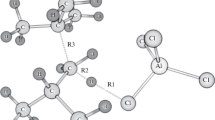Abstract.
β, γ-Substituted γ-halo allylalkoxide ions decompose to form a halogen ion, formaldehyde, and an alkyne under mild conditions, for example at room temperature. The E isomer does not differ from the Z isomer in terms of activation energy. We attempted to shed light on the mechanism of the reaction by using ab initio molecular orbital calculations. The observed propensity was confirmed by the present calculation on model molecules, γ-chloro allylalkoxide ions. We conducted further calculations and compared the alkoxide results with a similar reaction of β-haloacrylate ions that release carbon dioxide instead of formaldehyde. This similar reaction needs heating as high as 150°C. The activation energy of the acrylate ions (36–39 kcal mol−1) was calculated to be about 10 kcal mol−1 higher than that of the alkoxide ions. The activation energy of the E acrylate ion is smaller by 0.8 kcal mol−1 than that of the Z isomer at the MP2/6-31+G**//RHF/6-31+G* level of theory. This is consistent with experimental results. While the ready deprotonation from the carboxylic group does not activate the acrylate ion very much, the alkoxide ion is destabilized to a great degree in the process of anion formation. The difficulty in deprotonation that proceeds from the neutral molecule is seen in the difference in the activation energies for the decomposition of the corresponding anions. Therefore, the pK a of a hydroxy or a carboxylic group plays the leading role in determining the magnitude of activation energies of allyl halides with a negatively charged fragment.
Similar content being viewed by others
Author information
Authors and Affiliations
Additional information
Received: 2 July 1998 / Accepted: 9 September 1998 / Published online: 8 February 1999
Rights and permissions
About this article
Cite this article
Hori, K., Saitoh, N., Kobayashi, S. et al. Theoretical study on decomposition of γ-halo allylalkoxide and β-halo acrylate ions. Theor Chem Acc 102, 244–251 (1999). https://doi.org/10.1007/s002140050495
Issue Date:
DOI: https://doi.org/10.1007/s002140050495




